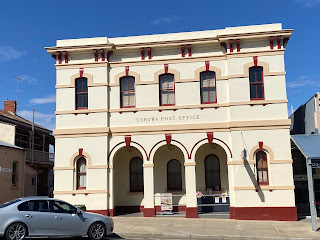After leaving Albury/Wodonga I headed to another town west and a bit north of Wodonga called Corowa. Like Albury and Wodonga, Corowa is also located on the Murray River (in New South Wales) and the other little town on the other side of the river, in Victoria, is Wahgunyah. Corowa played a crucial role in shaping Australian democracy with the People’s Convention held here in 1893. This event was the catalyst for the move towards nationhood and Federation. Corowa has since garnered the title of the ‘Birthplace of Federation’.
This two-storey brick building opened under the name, ‘Australian Hotel’in 1893 and in 1899 was the first building in Corowa to have the town water supply connected. The front was completely revamped in 1930 when the current art deco façade was constructed.
Following two previous Post Office buildings, the cornerstone for this Post Office was laid in 1880.
Built in 1880 and originally, and to this day, a solicitor’s office, this building also served as the meeting place for The Corowa Federation League Branch which became a driving force behind the holding of the Corowa Federation Conference in 1893.
Originally established in 1861, in 1893, as part of the Federation Conference, the Royal Hotel hosted the Official Opening Luncheon for the NSW politicians and delegates.
The gorgeous, little house I was staying at in Corowa.
A replica of a wine bottle in Rutherglen was constructed in 1900 to serve as the town’s water supply. This facility was a vital resource, supporting the growth of the town’s gold mining, agricultural and wine industries.
The Rutherglen Wine Bottle sits on top of the highest elevation in Rutherglen, overlooking the region’s scenic landscape.
Today I went to All Saints Estate - one of the larger wineries in Rutherglen. All Saints Estate is a family owned winery established in 1864.
Lining the road on both the entrance and exit of All Saints is a majestic 300 metre avenue of English Elm trees. Numbering 87, they were first planted around 1880 and are some of the oldest in Australia’s history.
Set within a heritage listed castle, the newly renovated Cellar Door modernizes the tasting experience. The All Saints Estate castle was based on the design of ‘The Castle of Mey’ in Scotland, and was built by hand by the original owners and founders of All Saints.
No better thing to do with a friend than go wine tasting!!
Lining the walls of the expansive ‘Great Hall’ are magnificent wine foudres coopered back in the early 1900’s. These barrels, or foudres as they are also known, hold up to 5000 litre of Muscat and Muscadelle (Tokay).
Look at that - terrible!! Wastage on the road!
Just think of it - filled with wine!! 🍷
All Saints Estate’s Chinese Dormitory was built over 100 years ago and is the last remaining example of its type in Australia. Many Chinese people came to find their fortune in the area’s gold fields and when gold mining eased, many then became employed as vineyard hands.
After a hard day of wine tasting it seemed like a good idea to sample more wine, this time in the hot tub!
An enormous crackle of cockatoos came to visit one morning. They were everywhere - thick in the trees! What you can’t understand from a photo is the noise they make!!
Time to leave the border and the Murray River and head east. Despite much more rain than usual in December and January there’s been little rain recently and the landscape is starting to brown.
A stop in Gundagai at The Dog on the Tuckerbox. Although a small town, Gundagai is a popular topic for writers and songwriters, and has become the representation of the typical Australian country town. The story of The Dog on the Tuckerbox is a part of Australia’s early folklore. The inspiration for the statue has been traced to a doggerel poem, “Bullocky Bill”, by Bowyang Yorke in 1857 and finally the legend was immortalized by Jack O’Hagan in 1937 in his popular song “Where the Dog sits on the Tuckerbox”.
Countryside around Gundagai
There’s not a lot of excitement in the sleepy village of Robertson, N.S.W., so the farmers got together and decided they should build a giant potato. The giant spud, which was built in 1977, measures about 10 metres long and four metres wide. Robertson is known for its fertile soil and high annual rainfall, making growing spuds in the area idea. The movie Babe was also filmed in Robertson.


































No comments:
Post a Comment